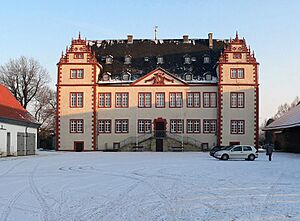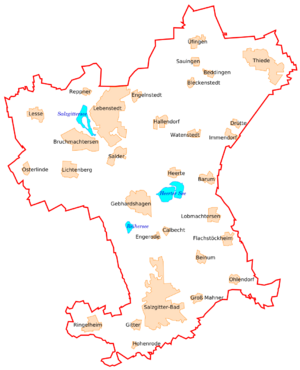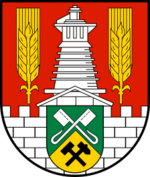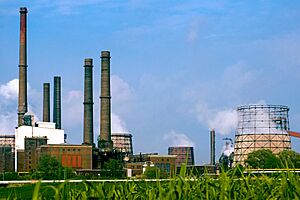Salzgitter facts for kids
Quick facts for kids
Salzgitter
|
|||
|---|---|---|---|

Salder Castle
|
|||
|
|||
| Country | Germany | ||
| State | Lower Saxony | ||
| District | Urban district | ||
| Elevation | 80-275 m (−822.2 ft) | ||
| Population
(2022-12-31)
|
|||
| • Total | 104,548 | ||
| Time zone | CET/CEST (UTC+1/+2) | ||
| Postal codes |
38226, 38228, 38229,
38239, 38259 |
||
| Dialling codes | 05341 | ||
| Vehicle registration | SZ | ||
| Website | www.salzgitter.de | ||
Salzgitter is a city in southeast Lower Saxony, Germany. It is located between Hildesheim and Braunschweig. Salzgitter is one of the seven main centers in Lower Saxony. This means it's a very important city for the region.
With over 100,000 people and a large area of about 224 square kilometers, Salzgitter has the biggest area in Lower Saxony. It's also one of the largest cities by area in all of Germany. The city started as many small towns and villages. Today, it has 31 different parts called boroughs. These parts are quite close together, but there's still a lot of open land between them.
The main shopping area is in the Lebenstedt borough. The city center is in the Salzgitter-Bad borough. Salzgitter is connected to important canals like the Mittellandkanal. This helps with transport and trade. The closest big cities are Braunschweig (about 23 km away) and Hanover (about 51 km away). Salzgitter became a "big city" (over 100,000 people) when it was founded in 1942. It was first called Watenstedt-Salzgitter. It's one of the few cities in Germany that was created in the 20th century.
Contents
- Understanding the Name of Salzgitter
- Exploring Salzgitter's Geography
- A Look at Salzgitter's History
- How Salzgitter's Population Has Grown
- Religions in Salzgitter
- Salzgitter's Coat of Arms
- Getting Around in Salzgitter: Transport
- Economy and Public Services
- Culture and Sights in Salzgitter
- Salzgitter's Twin Towns
- Notable People from Salzgitter
- Images for kids
- See also
Understanding the Name of Salzgitter
Before 1942, "Salzgitter" was the name of a town. This town is now part of the Salzgitter-Bad borough. From 1942 to 1951, "Salzgitter" was a borough within a larger city called Watenstedt-Salzgitter.
In 1951, the borough "Salzgitter" was renamed "Salzgitter-Bad". This freed up the name "Salzgitter". So, the whole city that was called "Watenstedt-Salzgitter" became simply "Salzgitter". Today, "Salzgitter-Watenstedt" is a small borough with only a few hundred people.
Exploring Salzgitter's Geography
Salzgitter is in a wide valley. This valley is covered with rich soil called loess. It lies between the Oderwald Forest and the Salzgitter Hills. The city stretches about 24 kilometers from north to south. It is about 19 kilometers from east to west. The highest point in the city is the Hamberg hill, which is 275 meters tall. It's located northwest of Salzgitter-Bad.
Cities and Towns Nearby
Salzgitter shares borders with several other cities and towns. These are listed clockwise, starting from the northeast:
- Braunschweig (an independent city)
- In the Wolfenbüttel district: The city of Wolfenbüttel, Cramme, Flöthe, Gielde.
- In the Goslar district: Liebenburg, Wallmoden, Lutter am Barenberge.
- Again in the Wolfenbüttel district: Sehlde, Haverlah, Elbe, Baddeckenstedt, Burgdorf bei Salzgitter.
- In the Hildesheim district: Söhlde.
- In the Peine district: Lengede, Vechelde.
How Salzgitter is Organized
The city of Salzgitter is made up of 31 boroughs. These are often called villages. Some of these boroughs include Bad, Lebenstedt, Ringelheim, and Salder.
These 31 boroughs are grouped into 7 larger areas called "towns". Each of these towns has its own elected mayor and town council.
Here are the towns and their boroughs:
- Town North: Lebenstedt, Salder, Bruchmachtersen, Engelnstedt
- Town Northeast: Thiede, Beddingen, Üfingen, Sauingen
- Town Northwest: Lichtenberg, Osterlinde, Reppner, Lesse
- Town East: Hallendorf, Bleckenstedt, Drütte, Immendorf, Watenstedt
- Town South: Bad, Gitter, Groß Mahner, Ringelheim, Hohenrode
- Town Southeast: Flachstöckheim, Barum, Beinum, Lobmachtersen, Ohlendorf
- Town West: Gebhardshagen, Calbecht, Engerode, Heerte
A Look at Salzgitter's History
From Salt Springs to a Modern City (1300–1982)
Salzgitter began in the early 1300s. It grew around salt springs near a village called Verpstedt. The name "Salzgitter" comes from "salt near Gitter," a nearby village. People started producing salt here around 1347.
For a long time, Salzgitter was a small town. It changed hands between different rulers. In 1830, a special bath using salty water (a brine bath) was opened in Salzgitter.
In 1929, Salzgitter officially became a chartered town again. Other small settlements joined it over time.
A big change happened because of the large amounts of iron ore found in Salzgitter. In 1937, a large company was founded to mine this ore and produce iron. To help this industry grow, a new, unified city was created on April 1, 1942. This new city was called Stadtkreis Watenstedt-Salzgitter. It brought together 29 different towns and villages.
During World War II, the city was important for iron production. Sadly, during this time, some camps were set up to provide forced labor for the factories. Salzgitter was heavily damaged by bombings during the war.
After the war, the city became part of the new state of Lower Saxony. In 1951, the city was renamed "Stadt Salzgitter." The borough "Salzgitter" became "Salzgitter-Bad" because of its brine bath. In 1974, two more municipalities joined the city, bringing the total number of boroughs to 31.
Iron ore mining continued in Salzgitter until 1982. Today, in a former mine called Schacht Konrad, there are plans to store radioactive waste safely underground.
How Salzgitter's Population Has Grown
The number of people living in Salzgitter has changed a lot over the years. Here's a look at how the population has grown, first for the old town of Salzgitter-Bad, and then for the larger city created in 1942.
|
|
||||||||||||||||||||||||||||||||||||||||||||||||||||||||||||||||||||||
Religions in Salzgitter
Historically, the Salzgitter area was part of the Hildesheim diocese. In 1568, the Protestant Reformation brought changes. The area became split between two Protestant church regions.
When the city of Watenstedt-Salzgitter was formed in 1942, all its churches became part of the Church of Brunswick. Today, all Protestant churches in Salzgitter belong to this church.
Roman Catholics in Salzgitter belong to the diocese of Hildesheim. They have their own local deanery.
Besides these main churches, Salzgitter also has other Christian groups. These include Baptists, the Church of God, Plymouth Brethren, and Seventh-day Adventists. There are also several New Apostolic Churches.
Due to people moving to the city for work in the 1970s, Salzgitter also has several mosques for its Islamic community. In 2011, Salzgitter had one of the highest numbers of Muslim residents among major cities in Lower Saxony.
Salzgitter's Coat of Arms
The Coat of Arms for Salzgitter has a silver furnace behind a silver wall. On the wall, there's a shield. The top of the shield is green with two salt-making tools. The bottom is gold with a black sledgehammer and a black iron piece. Behind the furnace, on a red background, are two wheat ears.
This Coat of Arms shows two important things about Salzgitter. The wheat ears represent agriculture, which is important for many villages in the city. The furnace, sledgehammer, and iron represent industry. This industry was a big reason why Salzgitter was founded.
This specific Coat of Arms was adopted in 1951. The city had different coats of arms before that. Like many German cities, Salzgitter also uses a modern logo. It's a green field with a white winding path that gets narrower in the distance.
Getting Around in Salzgitter: Transport
Roads
In the north of Salzgitter, there's a major highway called the Autobahn A 39. This road connects Braunschweig to the A 7 highway (which goes to Kassel and Hanover). Salzgitter has five exits to this Autobahn. To the east, there's another highway, the A 395 (Braunschweig to Goslar), with four exits from Salzgitter. Two other main roads also pass through the city.
Trains
Salzgitter has six railway stations. The most important one is in the Salzgitter-Ringelheim area. The most central station is in Salzgitter-Lebenstedt. There isn't one main train station (Hauptbahnhof) for the whole city.
Salzgitter-Ringelheim station is on a line that goes from Halle (Saale) to Hanover. Another line goes towards the Harz Mountains and Braunschweig, passing through Salzgitter-Bad. Salzgitter-Lebenstedt is the end of a local train line from Braunschweig.
Buses
Three different bus companies operate in Salzgitter. The bus system is very important. This is because Salzgitter is made up of many villages spread out over a large area.
Economy and Public Services
Media
In Salzgitter, you can read the daily newspaper Salzgitter-Zeitung. There's also a Sunday newspaper called Salzgitter-Woche am Sonntag. For events, there's the Salzgitter Szene calendar and the online magazine Salzgitter-aktuell. You can also watch the local TV channel TV 38 on cable television.
Important Companies in Salzgitter
Many important companies have operations in Salzgitter:
- Alstom Transport (makes trains and other transport equipment)
- Salzgitter AG (a big steel company)
- Volkswagenwerk Salzgitter (a car engine factory)
- Schaper & Brümmer (makes medicines)
- MAN (makes trucks and engines)
- Robert Bosch GmbH (a technology and services company)
- SMAG (makes cranes and other machines)
- IKEA (has its biggest warehouse in Salzgitter)
Public Institutions
Salzgitter is home to important public offices:
- The Bundesamt für Strahlenschutz, which is Germany's Federal Radiation Protection Office. It was founded in 1989.
- The Central Registration Office for the State Judiciary Administration of Lower Saxony.
Education
Since 1993, Salzgitter has had a campus of the Fachhochschule Braunschweig-Wolfenbüttel (a university of applied sciences). Here, students can study:
- Logistics and transport
- Logistics and information management
- Business engineering with a focus on traffic
- Tourism management
- Sport management
- Media design
There are also advanced study programs for those who have already completed a degree:
- Multimedia
- And by correspondence course: Quality and environment management, and Sale management.
Other campuses of this university are in Braunschweig, Wolfenbüttel, and Wolfsburg.
Salzgitter also has many regular schools and vocational schools. These include three grammar schools: the Gymnasium Salzgitter-Bad, the Gymnasium am Fredenberg, and the Kranich-Gymnasium. The last two are in Salzgitter-Lebenstedt.
For adult education, there is the Volkshochschule Salzgitter. It has locations in Salzgitter-Bad and Salzgitter-Lebenstedt.
Culture and Sights in Salzgitter
Libraries
Salzgitter has three public libraries. The main library is in Salzgitter-Lebenstedt. It has over 155,000 items like books and movies. There are also smaller libraries in Salzgitter-Bad and Salzgitter-Fredenberg.
Theatre
Salzgitter doesn't have a specific theatre building. However, plays and shows are performed in various places around the city. For example, in Salzgitter-Bad, a group from the local grammar school puts on amateur plays. They perform on different stages for audiences of various sizes. Sometimes, there are also musicals.
Museums
- Städtisches Museum Schloss Salder ("Municipal Museum Salder Castle"): This museum has free entry. It covers over 3,500 square meters. You can see permanent exhibits about geology, prehistory, and the history of the city. This includes things like an ichthyosaur fossil, tools from Neanderthals, and information about iron ore mining. There are over 3,000 items on display. The museum also has special exhibitions each year. Outside, you can see old machines, a working windmill, and an ice age path with life-size animal models like mammoths.
- Städtische Kunstsammlungen Schloss Salder ("Municipal Art Collection in Salder Castle"): This is an art collection also located in Salder Castle.
Buildings to See
- In Salzgitter-Lebenstedt:
- City monument (Turm der Arbeit – "Tower of Work"): This is a symbol of the city, built in 1995. It tells the story of people who suffered while building the industry during the past. It also tells about people who had to leave their homes and the city's spirit to rebuild.
- Town hall: Built between 1959 and 1963.
- Ice sports hall: Designed in a unique, far-eastern style.
- In Salzgitter-Bad:
- Old Town: Explore the historic part of the city.
- Thermalsolbad: A hot-springs brine bath for relaxation.
- Protestant church St. Mariae Jacobi: A church built in 1481 that also served as a military defense.
- Catholic church St. Marien
- Former Nicolai church: Now used as an event space.
- Salzgitter Bismarck Tower
- Former town hall: Located at the market place.
- Tilly house
- Farm house in Kniestedt: Now used for elderly care and a music school.
- "Beamtensiedlung": Houses built in the 1930s for employees of the ironworks.
- Pilgrimage church in Salzgitter-Engerode: A chapel built in 1236. It's one of Lower Saxony's oldest pilgrimage churches. It has old frescos (wall paintings) that have been uncovered.
- Wasserburg (castle), Salzgitter-Gebhardshagen: This castle is nearly 1,000 years old.
- Franzosenbrücke ("French bridge"): A stone arch bridge over the Innerste river near Salzgitter-Hohenrode.
- Salzgitter-Lichtenberg: Castle ruins. It was built by Henry the Lion, destroyed in 1552, and uncovered again in the 1950s. It has a look-out point and a restaurant.
- Salzgitter-Ringelheim: Ringelheim Castle: This was a former monastery, founded in the 10th century. It became secular in 1803. It has a beautiful Baroque church built in 1694 with a valuable organ. There's also a crucifix from around the year 1000. The castle has a large park called Schlosspark.
- Salzgitter-Salder: Salder Castle: This castle is the former symbol of the city. It was built around 1600 in the "Weser Renaissance" style. It used to be home to a noble family and then a duke. Today, it's a museum of local history. It has a castle church called Maria-Magdalena with a round shape.
- Salzgitter-Thiede: Convent Steterburg: A ladies' convent founded in 1003. Some buildings are still from the 11th century. The house of the abbess was built in 1691. The church is from 1752. In 1938, the area was changed into apartments.
Other Interesting Places
- Archeological excavation from the Stone Age in Salzgitter-Lebenstedt: See where ancient people lived.
- Farm house Salzgitter-Flachstöckheim: With an open-air stage and an English Park (from 1756/1821).
- Salzgittersee ("Lake Salzgitter") in Salzgitter-Lebenstedt: A great place for swimming, water-skiing, boating, rollerblading, and diving.
Regular Events in Salzgitter
- May: Municipal sports week in Salzgitter-Lebenstedt.
- May: Museum festival at Salder Castle in Salzgitter-Salder.
- May/June: Schützenfest (a German festival with shooting competitions) in Salzgitter-Bad.
- June/July: Altstadt-Festival (a festival in the old town center) in Salzgitter-Bad.
Salzgitter's Twin Towns
Salzgitter has special partnerships with other cities around the world. These are called twin towns or sister cities.
 Imatra, Finland (since 1970)
Imatra, Finland (since 1970) Swindon, United Kingdom (since 1975)
Swindon, United Kingdom (since 1975) Créteil, France (since 1980)
Créteil, France (since 1980) Stary Oskol, Russia (since 1987)
Stary Oskol, Russia (since 1987) Gotha, Germany (since 1988)
Gotha, Germany (since 1988)
Notable People from Salzgitter
- Friedrich Schlemm (1795–1859), a doctor and expert in anatomy.
- Heinrich Ahrens (1808–1874), a philosopher.
- Hermann Lattemann (1852–1894), a balloon pilot who experimented with early parachutes.
- Wilhelm Wassmuss (1880–1938), a diplomat and spy.
- Hagen Stehr (born 1941), a German-Australian tuna breeder and businessman.
- Hans-Joachim Gehrke (born 1945), a historian who studies ancient times.
- Harald Weiss (born 1949), a composer, director, and artist.
- Christian Zwarg (born 1968), an audio engineer.
- Şebnem Dönmez (born 1974), a Turkish movie and TV actress.
Sports Stars from Salzgitter
- Wolfgang Dremmler (born 1954), a footballer who played many games for Germany.
- Andreas Pospich (born 1961), a footballer who played over 330 games.
- Peter Lux (born 1962), a footballer and coach who played over 340 games.
- Henrik Stehlik (born 1980), a trampoline gymnast who won a bronze medal at the 2004 Summer Olympics.
- Daniel Theis (born 1992), a basketball player.
Images for kids
See also
 In Spanish: Salzgitter para niños
In Spanish: Salzgitter para niños










